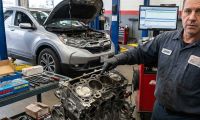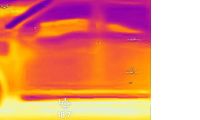According to the latest Ford media release , the new C-MAX heralds the arrival of Ford’s first application of the all-new 1.6-liter EcoBoost™ I-4 engine in its North American C-class vehicles, delivering a combination of responsive performance with improved fuel economy and reduced CO2 emissions.
The in-line four cylinder is no slouch, delivering up to 168 horsepower with non-premium fuel and 173 lb.-ft. of sustained torque, while reducing CO2 emissions compared to larger-displacement engines with similar power. Of course, the I-4 configuration already implies better gas mileage, but is only understood within the context of combining its three combustion supporting technologies as a system.
Fact is, three distinct technology components contribute to EcoBoost’s torque, flexibility and fuel economy breakthroughs. The 1.6-liter EcoBoost I-4 uses a combination of advanced combustion technologies such as twin independent variable camshaft timing (Ti-VCT), turbocharging and direct gasoline injection.
Part of the performance gain comes from the twin independent variable camshaft with its precise, variable timing control of both the intake and exhaust camshafts, which direct the valve opening and closing events.
The high-pressure direct injection depends on a cam-driven, high-pressure mechanical fuel pump which operates at up to 2,220 psi – more than 50 times the norm seen in a conventional I-4 engine. On each stroke, six individual jets on each fuel injector spray fuel directly into the combustion chamber, mixing with the incoming air. By bringing the fuel injector right into the combustion chamber, there’s no delay from the time the fuel is injected to when it’s used by the engine.
Peak torque across a very wide engine speed range is one of the key characteristics that Ford wanted for its EcoBoost engine line, especially in smaller displacements. That is why Ford engineers chose a state-of-the-art turbocharger to ensure virtually lag-free operation at all engine speeds; plus it works well with its unique direct-gasoline injection system. In service, the turbo spins at up to 200,000 rpm and is designed for a life cycle of 150,000 miles or 10 years.
According to an earlier media release, Andrew Brumley, Ford chief program engineer, was quoted as saying, “Accelerating away from a stoplight and passing maneuvers require just a light press on the throttle to get the job done – the engine doesn’t have to spin to high rpm to generate the necessary power.”
And to mitigate that familiar turbocharger “whoosh” , Ford engineers opted to place electronically controlled anti-surge valves that proactively relieve the boost in the intake, which can range up to 17 psi. Careful software calibrations manage the pressures in the intake manifold, and an air-to-air intercooler lowers air temperature before it reaches the engine, resulting in a denser, cooler intake charge.
All together, the three key technologies alone do not account for EcoBoost success. Each is managed as part of a combustion system. That lies in a complex control system using hundreds of thousands of lines of computer code and related parameters.
Through extensive research and testing, Ford engineers have developed proprietary software strategies which integrate the engine, transmission and fuel management for dynamic driving.
__________________________
Additional Reading:
Ford C-Max Features a World First Hands Free Liftgate
Nissan's HR12DDR engine implies longevity for the internal combustion engine
Chevy Volt proves EV1 technical knowledge not wasted










